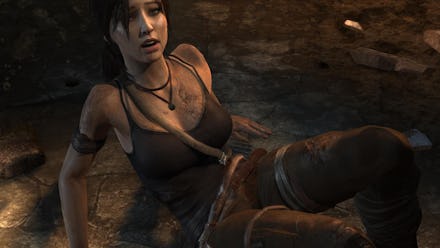After 19 Years, This Badass Heroine Is Still Being Treated Like a Piece of Meat

At Electronic Entertainment Expo 2015, many classic video games were reinvented for the modern age. Fans got the opportunity to watch developers and industry leaders talk about how they revitalized old franchises and beloved characters through innovation in technology, storytelling and old design frameworks.
Lara Croft, hero of the classic action series Tomb Raider, got a very different treatment.
In a behind-the-scenes glance at the new title Rise of the Tomb Raider, we didn't hear about the title character's new story, the development of her character or the new worlds she will explore. Instead, we got a sneak peek at the creation of her digital body.
"Because Tomb Raider is all about Lara and her journey, we always want to make her feel as human and believable as possible," game director Brian Horton said on stage at E3.
We toured the pores on her skin, her eyelashes, the detailing of her scars, the way she gets bloodied — the textural, tactile things drawn from full-body scans of live models to give the viewer the impression that Croft is, as the developers put it, "lifelike."
A false sense of empowerment: Lara Croft may be an action hero, but for nearly two decades, gamers and developers have obsessed over her exaggerated sexuality. It's a trope that political science professor Caroline Heldman calls the "Fighting Fuck Toy" archetype.
"Even though she is doing things supposedly on her own terms, she is very is objectified and exists for the male viewer," Heldman says in the documentary Miss Representation, which uses Angelina Jolie's onscreen depiction of Lara Croft as a specific example of this trope.
In addition to physical objectification, plot elements in recent games have increasingly portrayed Lara as emotionally sensitive and vulnerable to the brutality of a world filled with burly male antagonists. That development was met with similar criticism for how it adopted equally sexist tropes.
"This undertone helps to add vulnerability to the new Lara Croft game and reminds you, yet again, that she is indeed, just a girl," Louisa Peacock wrote for the Telegraph when the series was rebooted in 2013. "Just a girl, who, in a man's world, is still open to the threats and abuses and intolerances of bad men: She is judged, taken advantage of, 'abused,' attacked — all by men." (The 2013 release did, however, pass the Bechdel Test.)
When the game came out, fans set about programming modified versions that stripped Croft of her clothing. "Although I will admit it kinda strips away the strong female survivalist realism when we break Lara down to her tattered bra and deer skin chaps," wrote Complex, "it's nothing if not entertaining."
Since Tomb Raider first debuted in 1996, it's been a struggle for gamers and reviewers alike to talk about a female protagonist without resorting to sexist cliches, as BuzzFeed points out. (One memorable line: "Indiana Jones with breasts is back and it's her best PlayStation adventure yet.") Focusing Lara Croft Go on nothing but Croft's body won't do much to fix this problem.
Correction: June 17, 2015